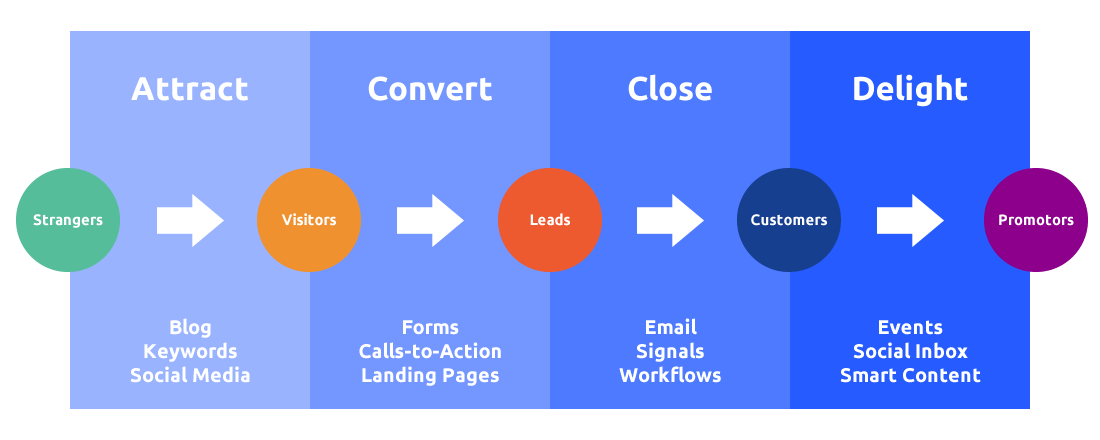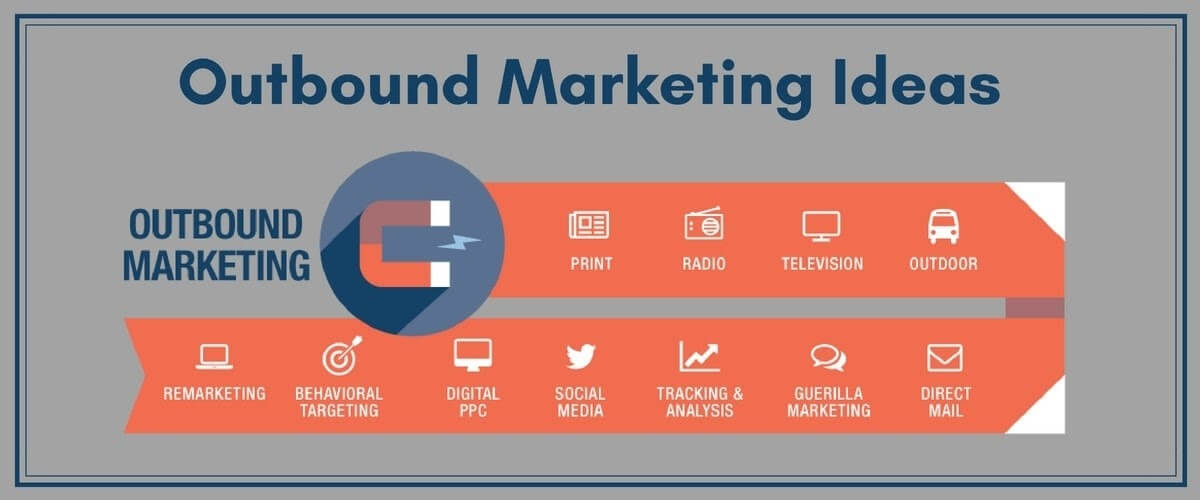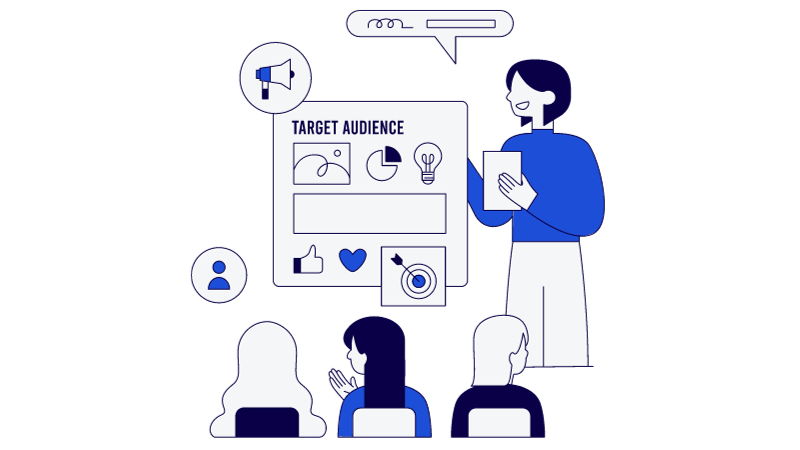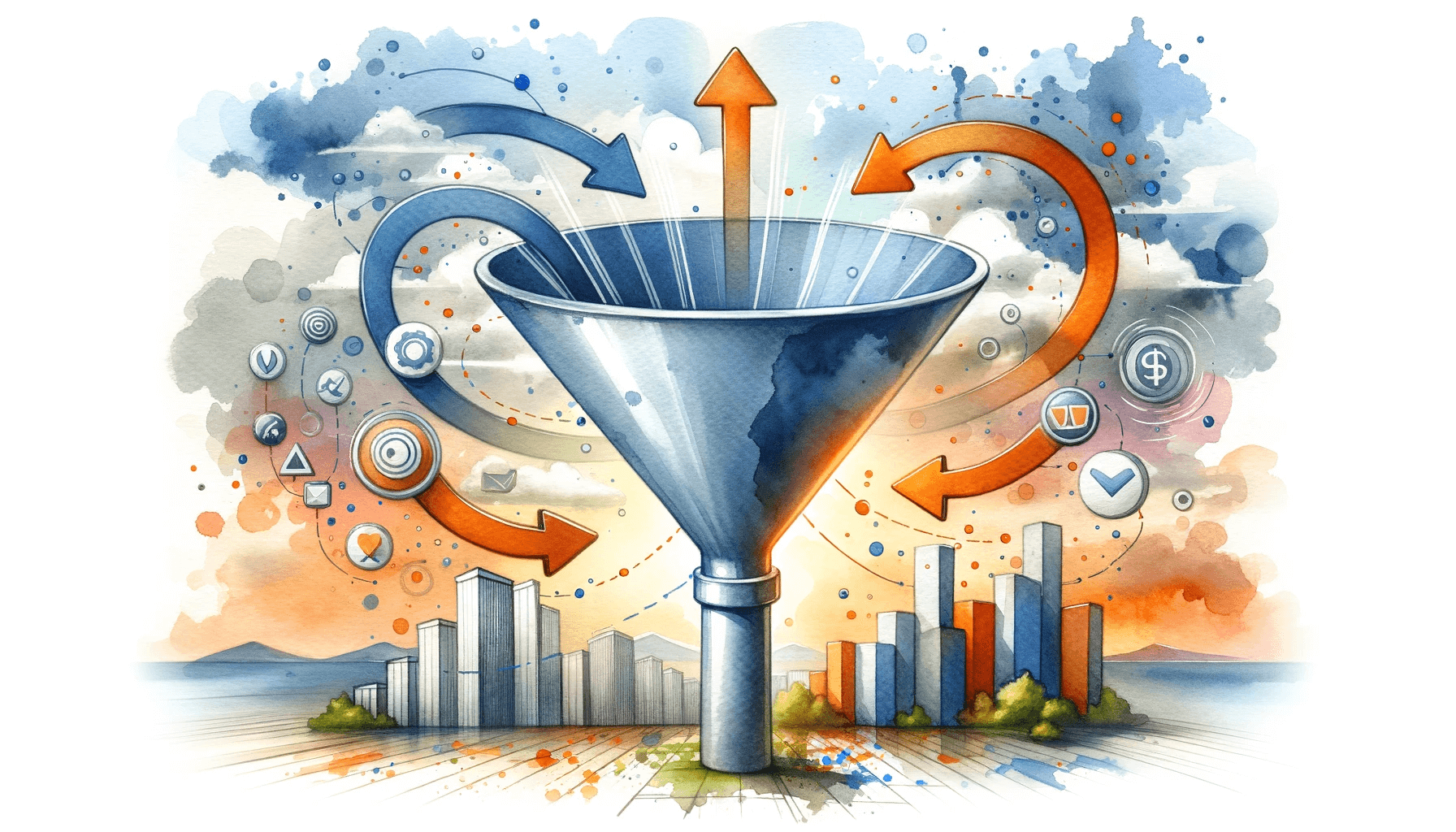You wake up, check your phone, and immediately delete three spam emails without even opening them. Make your coffee, hop in the car, and encounter a handful of billboards on the way to work.
Drive home, tuning out the loud, angry men arguing on a talk show, and the ads that too frequently interrupt them. Get home, realize your sister’s birthday is next week, look up great gifts for cat-lovers, and send her one. Make dinner, using a recipe that was emailed to you by a food blog you follow and go to sleep.
We all encounter an endless barrage of marketing every day. Some of that marketing is effective and made with the help of sales AI, and some of it’s, well, annoying. This division between effective and ineffective marketing strategies can be acutely seen when comparing inbound vs outbound marketing.
This guide will cover the differences between the two and much more. Here are the sections to follow:-
- Inbound Marketing: The “pull” strategy
- Outbound Marketing: The “push” strategy
- Difference Between Inbound vs Outbound Marketing
- Inbound vs Outbound Marketing: Based on Audience Behaviour
- Inbound vs Outbound Marketing: Based on Technology
- Inbound Marketing Challenges and How to Overcome Them
- Outbound Marketing Challenges and How to Overcome Them
- Inbound or Outbound Marketing for Your Business? Which One To Choose?
- Conclusion
Inbound Marketing: The “pull” strategy

Inbound marketing is a customer-focused approach technique that focuses on acquiring and engaging a target audience through relevant content and experiences. Rather than pushing your products or services to your customers, it is all about making genuine connections with them.
As a result, it is known as the ‘Pull’ tactic.
Here are some of the most popular inbound marketing channels used by businesses
- Content marketing:- Creating articles, blogs, and other forms of content.
- SEO:- The process of optimizing content (blog posts) in order to rank higher in search engines.
- Social media marketing:- Interacting with audiences channels like as Facebook, Twitter, and LinkedIn
- Email marketing:- Sending tailored emails to subscribers.
Outbound Marketing: The “push” strategy

Outbound marketing is a traditional marketing method of reaching out to potential customers via multiple channels. The traditional advertising tactics comprised television ads, radio, print media, and billboards.
The same push approach is now being used in digital media, with ads on social media and cold outreach via DMs, phone calls, and emails.
Here are some of the most popular outbound marketing channels used by businesses:-
- Traditional advertising:- Ads on television, radio, and print advertisements.
- Direct mail: Sending promotional mails to potential buyers directly.
- Trade shows: Participating in offline events to display products or services
- Digital Outreach:- Cold emails, Cold DM’s and Cold Calls
Difference Between Inbound vs Outbound Marketing
This section is written to help you grasp the differences between inbound and outbound marketing efforts at a surface level. Here you will get a simple understanding of pros and cons of both.
| Inbound Marketing | Outbound Marketing |
| 1) Inbound marketing is all about the pull. It entices the audience with value and then pushes products to your customers. | 1) Whereas Outbound marketing is all about pushing our products and services in front of people. |
| 2) Inbound marketing focuses on customers first. | 2) Outbound marketing relies on the product/offer first. |
| 3) Inbound marketing is largely done online through blogs and social media. As a result, it’s ‘Trackable’. | 3) Outbound marketing is done both offline and online. Such as billboards, TV commercials, and Meta advertising too. But some of these campaigns are ‘un-trackable.’ |
| 4) The emphasis is on audience who are either interested in their product (or) aware of their problem. Hence covering the whole sales funnel. Audience are nurtured. | 4) The emphasis is on a wide spectrum of audiences. As a result, you may find yourself targeting an unqualified set of audience. Hence audience are not in a nurture sequence. |
| 5) Inbound marketing is about creating brand awareness, hence it’s a long-term strategy. | 5) Outbound marketing is about generating leads/sales to the business. Hence it’s a short-term strategy. |
| 6) The success of this strategy is determined by the quality of your content and activities. | 6) Here, quantity determines success. What matters most is the volume of outreach and the number of ad impressions. |
We feel a short table will not justify the actual depth of this article. Hence we’ll go over both marketing methods in detail in the following sections.
Inbound vs Outbound Marketing: Based on Audience Behaviour

Audience behaviour and preferences are a critical factor in distinguishing between inbound and outbound marketing. For effective marketing, it’s damn important to understand your audience and where they stand in your funnel.
Without proper analyses of your target audience behaviour, will leave your marketing tactics worthless.
Outbound Marketing (Audience Behaviour):–
1. Reactive Response: In outbound marketing, the audience often reacts to the information offered to them, whether it’s a television commercial, a billboard, or a cold call. Their participation is frequently spontaneous and depending on the advertisement’s immediate impact.
2. Short Attention Span: Because outbound techniques are obtrusive, the audience may have a shorter attention span. If the message does not resonate with them within the first few seconds, they will most likely move on or disregard it.
3. Broad Audience: Outbound marketing frequently targets a broad audience. As a result, not every viewer or listener may find the topic relevant, resulting in a wide range of varied responses
4. Seeking Quick Value: When a prospect responds to an outbound advertisement, they frequently seek quick value or benefits, such as discounts, promotions, or limited-time deals.
Inbound Marketing (Audience Behaviour):–
1. Proactive Engagement: In inbound marketing, the audience are actively seeking for information or solution to their problem. They might look for a blog post, view a tutorial video, or sign up for a newsletter because it is useful or relevant to their requirements.
2. Increased Engagement Time: Because the audience chooses to connect with the content, they spend more time learning, reading, or watching. Thus resulting in greater engagement.
3. Specific Interests: Inbound marketing is designed to address unique audience concerns or interests. As a result, the content is precisely targeted and relevant to those interests, resulting in higher conversion rates.
4. Relationship Building: Inbound marketing audiences are frequently looking for reliable sources of information or answers. Thus offering consistent and valuable content can lead to the audience forming a relationship with or loyalty to the brand over time.
Inbound vs Outbound Marketing: Based on Technology

Technology is at the forefront of redefining marketing techniques in today’s digital world, that includes both inbound and outbound approaches. With the help of tech, there are plenty of new ways through which marketers have been leveraging these strategies for their businesses.
What Technologies impact Inbound Marketing?
1. Content Management Systems (CMS): Platforms such as WordPress or HubSpot help businesses to efficiently develop, manage, and optimize website content, ensuring it effectively reaches the target audience.
2. SEO Tools: Tools like SEMrush and Ahrefs provide insights into keyword rankings, backlink profiles, and competitor analysis, allowing businesses to structure their content for improved search visibility.
3. Social Media Platforms: Sites such as Facebook, Twitter, and LinkedIn have potential prospects on their platforms, allowing businesses to reach out to certain demographics and interact with their audience in real time.
4. Analytics: Google Analytics and other comparable tools provide insights into user behaviour, traffic sources, and conversion rates, helping businesses with understanding the efficacy of their inbound efforts and making any improvements.
What Technologies impact Outbound Marketing?
1. Customer Relationship Management (CRM) Systems: Platforms such as HubSpot, Salesforce, or Zoho CRM help businesses in managing leads and customer interactions, thus ensuring timely and appropriate communication.
2. Email Marketing Platforms: Tools like Instantly AI that are used for cold emails to reach out to a large number of people at once. Alongside tools like LeadBoxer can help you in collecting leads for your outreach by providing leads.
3. Programmatic Advertising: Advanced algorithms automate media inventory purchase, placement, and optimisation on ads. Thus ensuring ads to reach the correct audience at the right time.
4. Retargeting Tools: Cookies and other technologies track user’s online actions, allowing businesses to provide tailored ads to their consumers who have previously interacted with their website or products. However, because to privacy concerns, Apple and other platforms are clamping down on this.
As technology advances, it will undoubtedly play an increasingly greater role in determining the future of marketing including both inbound and outbound.
Inbound Marketing Challenges and How to Overcome Them
While being effective, inbound marketing has its own set of obstacles. Understanding these challenges and developing solutions to overcome them is critical for success.
1. Saturation of Content:–
Challenge: With so much content available online, standing out and capturing the audience’s attention is becoming increasingly tough.
Solution: Concentrate on producing high-quality, distinctive, and value-added content. Do extensive keyword research and research in general in order to meet specific audience inquiries.
2. Longer Time to See Results:-
Challenge: Unlike outbound marketing, which can produce quick results, inbound techniques can take time to gain traction.
Solution: Be persistent and patient. Monitor and adapt your plans on a regular basis based on analytics and feedback. Celebrate minor victories while keeping in mind that inbound marketing is a long-term commitment.
3. Changing Search Engine Algorithms:-
– Challenge: Search engines, particularly Google, regularly updates their algorithms, which can have an influence on website rankings.
– Solution: Stay updated on SEO changes and best practises. Consider creating content for both people and search engines as a priority.
4. Engaging the Right Audience:-
Challenge: Getting traffic is one thing, but getting the right traffic that converts is another.
Solution: Develop detailed buyer personas to better understand your target customer.
5. Creating Consistent Creation:-
Challenge: Creating fresh and relevant content on a regular basis can be time-consuming.
Solution: Have a content calendar in place to plan and schedule content ahead of time. To keep them coming, consider collaborating with guest authors or outsourcing your content generation.
Outbound Marketing Challenges and How to Overcome Them
Just like Inbound marketing, outbound marketing has it’s own set of challenges.
- Higher Costs:-
Challenge: Outbound marketing strategies, such as TV commercials or billboards, can be costly.
Solution: Spend your money wisely by focusing on platforms and channels that provide the best ROI. If you’re a small online business, shift to Meta ads or cold outreach.
- Intrusive perception:-
Challenge: Consumers frequently perceive outbound ads as interruptions, especially when they are irrelevant.
Solution: Make sure your messaging is focused. Understand your audience’s preferences by using data analytics. Tracking website visitors and email click-throughs can help you develop an understanding of your audience’s behaviour and preferences.
- Tracking ROI:-
Challenge: Traditional outbound campaigns, unlike digital methods, are difficult to measure. Hence their direct impact on the businesses can be attributed.
Solution: If possible, you can incorporate tracking measures, such as unique promo codes for offline marketing. If you use cold emails, however, our Outlook email monitoring can assist you in tracking your efforts.
- Rapidly Changing Consumer Habits:-
Challenge: With the rise of ad-blockers and streaming services, traditional advertisements may no longer reach as broad an audience as they once did.
Solution: Expand your marketing mix. While TV and radio advertisements are still effective, consider incorporating digital outbound strategies like running cold email campaigns or pay-per-click ads.
- Compliance and Regulations:-
Challenge: Outbound marketing, particularly telemarketing and cold email operations, might face stringent laws.
Solution: To prevent legal ramifications, keep up with the latest updates on local and international marketing regulations.
- Saturation and Competition:-
Challenge: As more and more businesses use outbound strategies, it leads to market saturation and makes it difficult to stand out.
Solution: Concentrate on generating captivating and memorable campaigns. Understand your unique selling proposition (USP) and make sure it’s featured in all of your marketing content.
- Short-term Effect:-
Challenge: The influence of outbound marketing, such as a television commercial, can be brief.
Solution: Strengthen your campaigns across multiple media. If you have a TV ad, supplement it with radio spots, print advertisements, and internet banners to ensure consistent visibility.
Inbound or Outbound Marketing for Your Business? Which One To Choose?
If you run a business of this era, then your primary objective should be to test out all possible channels over time and establish your own brand. Because people love brands and once they start seeing your brand name everywhere they start trusting you more.
This is where, integrated marketing, the big brother, steps in.
Integrated marketing is a comprehensive approach that incorporates both inbound and outbound marketing methods to provide consumers with a united and seamless experience. Thus making your business have that omnichannel presence.
Rather than considering each marketing channel separately, integrated marketing considers all channels to be interrelated components of a wider ecosystem. The primary purpose is to ensuring that all marketing initiatives, online and offline, present a consistent and cohesive brand message.
Examples Highlighting the Effective Integration of Both Strategies
1. Nike’s “Just Do It” Campaign:-
Overview: Nike’s classic “Just Do It” campaign effortlessly combined TV advertisements (outbound) with social media participation (inbound).
Results: Not only did the campaign boost sales, but it also created a community of dedicated customers who connected with the company online, sharing their own “Just Do It” moments.
2. Coca-Cola’s “Share a Coke” Marketing Campaign:-
Overview: Coca-Cola customised their bottles with common names and encouraged people to share their “Share a Coke” experiences online.
Outcomes: The campaign resulted in a huge boost in sales as well as a massive influx of user-generated material on social media, demonstrating the successful blending of traditional advertising and digital interaction.
3. Dove’s “Real Beauty” Campaign:-
Overview: Dove began a series of television commercials that questioned beauty norms. They supplemented it with online content, such as films and essays about actual beauty.
Results: The campaign resonated emotionally with consumers, leading to widespread media coverage and a surge in online discussions regarding beauty standards.
4. Airbnb’s “Live There” Marketing Campaign:-
Overview: Airbnb promoted the idea of experiencing cities like a local through television advertisements. This was coupled with their internet platform, which allowed customers to find local experiences and accommodations.
Outcomes: The campaign successfully positioned Airbnb as more than a housing provider, emphasising the unique experiences it provides, resulting in increased bookings and user engagement.
These case studies demonstrate the value of combining inbound and outbound initiatives. When done well, integrated marketing can magnify brand messages, create deeper engagement among consumers, and generate measurable business results.
Conclusion
While each marketing technique has its advantages, it is the harmonious combination of both that accelerates a brand’s success.
However, we recommend small businesses in the B2B space to begin with outbound channels such as cold emails and cold emails. Because you can easily contact your target audience and make money in the short-run.
Using services like Lead Boxer an excellent place to start searching for leads for your outbound email campaigns.
However, once your company is up and going, the emphasis should be more on creating a brand. Like that businesses can develop strong, long-lasting relationships with consumers by producing consistent, high-quality content and engaging with audiences across many channels, resulting in increased growth and brand loyalty.
